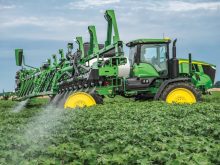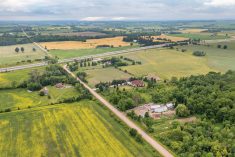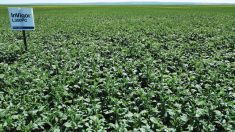[UPDATE: Oct. 29, 2019] Hybrid wheat certainly isn’t the only new product BASF has in the development pipeline, but it is an indicator of the game-changing technology the long time “pulse crop” company plans to deliver to western Canadian farmers in a vastly expanded cropping systems role over the coming years.
While field trials of early generations of hybrid hard red spring wheat are producing yields in the 120 bushel per acre range, it is expected to be another five years before the high yielding, high-quality varieties are available to Canadian growers — variety performance needs to be confirmed, seed growers need to be lined up.
Read Also

Claas brings 1000 Series SP forage harvesters to Canada
In mid-August, Claas unveiled its new line of Jaguar forage harvesters at an event in Visalia, California, deep in the heart of that state’s dairy region.
“Hybrid wheat will be a revolutionary development for Canadian farmers,” says Brent Collins, BASF North American seeds marketing manager, based in Calgary. Over the past 10 years, about half a billion dollars has been invested in the development of the new non-GMO wheat. “They will be varieties that not only offer high yields, but yield stability. It will take wheat production to a whole new level,” he says.
The late October update on hybrid wheat development was just one of nearly a dozen presentations covered by company officials meeting with agriculture journalists during a media day at the North American headquarters in Durham, North Carolina.
The event kicked off with a farmer panel discussion on the challenges of agriculture which included Kristjan Hebert of Moosomin, Sask., Darren Armstrong, of Hyde County North Carolina, and father and son team Ben and Hans Riensche of Jesup, Iowa.

Along with BASF division heads from North American operations, reporters also heard from Vincent Gros, president of Agriculture Solutions and Saori Dubourg, a member of the BASF board of executive directors both based at world headquarters in Germany.
New face of BASF
In many respects, the media day was a launch of where this large, 150-year-old multinational corporation is planning to take its agricultural division following the acquisition of *7.6 billion Euros (or about $11 Billion Cdn) worth of assets from the Bayer Corporation about 14 months earlier. Gros and Dubourg both described it as “a new chapter, the changing face of BASF.”
BASF didn’t just buy the InVigor line of canola seeds from Bayer, says Jon Sweat, vice president in charge of BASF agriculture operations in Canada.
“On August 1, 2018, we woke up that day to realize we had gone from being primarily a pulse company to a market leader in Canada,” says Sweat. “One out of every three dollars spent on crop inputs was coming to BASF, and with that came a tremendous responsibility.”
Chemistry is the foundation of the global company that last year had about 62 billion Euros (or $90 billion Canadian) in sales and 6.5 billion Euros (or $9.2 billion Canadian) in earnings across seven key divisions. Globally BASF has 122,000 employees at more than 350 sites and 90,000 customers from various sectors in every country in the world.
Agriculture products and services represent about 18 per cent of its total business, and. In the U.S. and Canada that includes a commitment to major field crops such as cotton, soybean, canola and wheat. But the agriculture division is developing a role far beyond being a marketer of herbicides and fungicides, says Sweat.
“One of the first things we did was to change our name from BASF Agricultural Products to BASF Agricultural Solutions,” says Sweat. The Canadian head office was relocated from Mississauga, Ontario to Calgary, to be in the heart of the company market place, and in a major logistical feat, BASF also changed its distribution system so the company delivers products directly to retailers rather than through a wholesaler.
“The change in distribution gives us much better control of our inventory and for farmer customers, it means we can have any products available in our warehouses to them within 24 hours and that timeliness is important,” says Sweat.
“Solutions” in the company name refers to the broad range of products and services BASF offers. The company claims the widest portfolio of herbicide modes of action, it is the leader with its seed treatment portfolio, a leader in field crop seed production and development including InVigor lines representing about 60 per cent of the Canadian canola market, as well as being a leader in soybean and cotton production in the U.S. And of course, hybrid wheat is in the pipeline. Through acquisitions, BASF is also a leading developer and supplier of seed to the vegetable production industry.
Plenty of new technology
One of the most exciting new areas of technology particularly of interest to Canadian farmers is Xarvio digital farming solutions. It captures an enormous existing and ever-growing database, accessible through a phone app to be used as a crop management tool.
As Xarvio principals Chris Patterson and Brent Nicol explained, farmers can use the weed, disease and insect database in the program to identify pests in their field and then make real-time decisions about treatment options.
The global database so far covers 40 different crops, can recognize 123 different weeds and 182 different crop diseases and an increasing number of insects.
As a simple example of what the service can ultimately do, a farmer can take a photo of leaf damage from a disease, have the Xarvio database identify the type of disease as well as rate of severity or treatment threshold. As more farmers use the service, Xarvio also has a radar function that can collect data from a 10-mile radius of your farm, to provide a regional view of disease levels. That provides information as to the disease severity in your area.
Xarvio has also partnered with Bosch, a company known for making household appliances that also manufactures field sprayers with variable-rate capability. With the disease identified and mapped over a field, the sprayer can be programmed to apply treatment as needed to affected areas of the crop. The same technology could be applied to weeds and insect pests.
Xarvio, headquartered in Germany, employs 200 people and already has 1.2 million users in 100 countries across North and South America, Europe and Asia. Xarvio continues to expand its data and develop partnerships with agriculture manufacturers and service providers.
Mark Shillingford, BASF manager crop protection products, says several new products with improved effectiveness and new modes of action will be introduced to the Canadian market over the next few years such as the seed treatment Teraxxa, that provides effective wireworm control in cereals. New fungicides are being developed to help control fusarium head blight in wheat, and Engenia is a new broadleaf weed control product that can be used in soybeans.
Two other key messages hammered home during presentations involved BASF’s ongoing commitment to sustainability, not only by reducing its own corporate environmental footprint, but to deliver products that improve farm sustainability — products that improve production with lower application rates.

BASF also emphasized the value of partnerships in all aspects of the ag industry. From a producer standpoint Garth Hodges, vice president global business management, Canola, described how BASF had worked in partnership with Cargill to develop a canola variety with very specific oil quality characteristics to be used in the manufacture of Oreo cookies. That variety is now produced in a closed-loop system to supply a specific market.
Malin Westfall, U.S. cotton lead, described how BASF’s e-3 cotton — socially equitable, economically viable and environmentally responsible — is being grown to produce specific lines of blue jeans in partnership with major clothing companies. Through the e-3 system, specific cotton varieties can be traced from seed through to grower, to the gin mill and then to the finished product in the store. They can stamp the farmer’s name and farm location on the inside of a jean pocket so consumers know where the cotton grown for their jeans came from and how it was grown.
Paul Rea, senior vice president agricultural solutions North America, says the opportunity to increase production exists. He pointed to a record-breaking corn yield of 542 bushels per acre, compared to the industry average of 177 bushels per acre, or the record canola yield of 85.8 bushels per acre compared to the industry average of 42 bushels and record-breaking soybean yield of 190 bushels per acre compared to the industry average of 51.6 bushels. He says ongoing research and development, using the latest technology, working with industry partners in balanced and sustainable production systems will help close that yield gap.
*UPDATE: The dollar amount for the acquisition previously indicated $81-billion worth of assets.
















